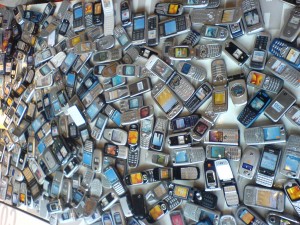An Emergent Syntax of Stuff
August 17, 2011In the 2006 comedy Idiocracy, Mike Judge depicts the Great Garbage Avalanche of 2505. That falling mass is almost certainly full of original iPads, first generation iPods, and antiquated iPhones, along with device-specific chargers and trashed FM transmitters. Technological advances have their costs. More pernicious than the stylized movie threats of new weapons or rampaging dinosaur clones, we face a not-so-subtle and advancing threat: the exponential growth of stuff.
This is the environmental impact of planned obsolescence, or the design practice of deliberately providing a product with a limited useful life. Items are created with intentional shortcomings to force users to make ancillary purchases. It’s no surprise that the sale of consumer electronics accessories represents $10 billion in annual revenue. Most consumers plan to use their accessories for a few years, but when the form factor, or geometry of a product, shifts from generation to generation—common among smartphones—accessory purchases may become more regular. Think of all those dead dongles: DisplayPorts replaced by Mini DisplayPorts, FireWire replaced by Thunderbolt.
Our minimalist visions of gleaming starship bridges are in stark contrast to this rat’s nest of wires and adapters. There is hope, however, that this inelegant mess is on the verge of a radical reorganization. In chaos theory, systems on the verge of transformation tend toward wilder, noisier behavior. Imagine a wobbling top right before it falls.
The work of Harvard mathematician and biologist Martin Nowak supports this hypothesis. In his work on the evolution of syntax in human language, he turned to the science of emergence – how greater levels of order and complexity appear from the interactions of simpler parts. Nowak argues that at some point in human development, the number of situations we needed to describe exceeded our ability to easily remember a new word for each scenario. It became easier to develop new parts of speech and combine them for a multiplying effect than to continue creating distinct calls.
“Lion behind you!”
“Lion in front of you!”
“Lion on your left!”
“Lion on your OS X!”
Humans were suddenly able to talk about many different kinds of lions, and to apply locational descriptors to any number of objects, without having to memorize a new term for every situation.
This is what makes written Chinese so much more difficult to learn than English. Chinese, as an older language, uses hundreds of pictographs to identify every unique referent, whereas English has only twenty-six letters that can be endlessly reassembled to make new words.
Likewise, the most sensible designers are dedicated to creating multiple-function technologies. First came the Swiss-Army Knife, then a screwdriver with interchangeable bits. Now television programming is available online, eliminating the need to purchase both a computer and a dedicated TV monitor. We no longer need to carry a discman and a cellular phone, along with a note pad, a pocket calendar and a flashlight. A single smartphone puts all of these functions and more at our fingertips. We can now read under the starlight with a backlit iPad, then check the names of said stars on the same iPad, built with more computer power than NASA used to reach the Moon.
Technologies like the tablet and the smartphone, while still indulging in some planned obsolescence, set exemplary standards for multi-functional devices. Now products in the accessories category must catch up. By creating accessories that are form factor independent—that work on an original iPad or an iPad 2, a Galaxy Tab or a Kindle—designers contribute to a harmonized language, instead of a cacophony of one-use words. By inventing ecosystems of accessories with interchangeable functions, developers demonstrate consideration for the consumer and the environment. By releasing updates and upgrades that are backwards compatible, they accomplish the same.
Nowak’s logic is indisputable. We may not all have tricorders yet, but as our increasingly complex world demands an emergent syntax of stuff, there will come a day when planned obsolescence is a thing of the past. Smart devices will interact intelligently to evolve new functions, and smart accessories will interface comfortably with the human body to create a seamless digital experience.







One of the interesting effects of progress is that our expectations of the device changes over time. A great example: the automobile. Today we expect cars to move at great speeds with greater safety, navigate, entertain passengers (video), provide high quality sound systems, haul large amounts (inside) and large bulks (attached) of cargo, burn cleaner gas, adapt to multiple forms of energy and so on. It the car of today even the same product as the car of Henry Ford?
This topic reminds me of a new material that I recently came across. There are now polymers (http://www.nature.com/news/2011/110420/full/news.2011.251.html) that can heal themselves when placed under ultraviolet light. Just imagine creating a product that could fix itself. For marketing gurus, a self-healing product may be laughable. Perhaps, this is not the case. Consumers may be drawn to the product for its ability to self-heal, but would buy a new product in the future due to trends in color, shape, or functionality.
Abbey – I believe, after Paul Hawken, that we’re entering an post-consumer age when durability and quality are valued more greatly than inexpensive disposable convenience.
I think the greatest driver of obsolescence is how quickly new technology is replacing the old. Won’t we eventually get to a point where a smartphone is smart enough to stay relevant for more than a couple of years?
Smartphone? We won’t have them by the time this REALLY takes off:
http://www.antipope.org/charlie/blog-static/2009/05/login_2009_keynote_gaming_in_t.html
Very tech. info. At my age not very understandable. But I appreciate the possibilities of the future and I wish you well in your efforts in this tech.age. M.T